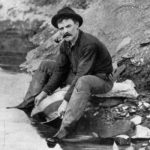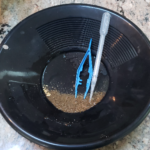
Are you interested in trying your hand at gold panning here in the mountains?
Let’s Get Started
Grab a pan and get started in just about any stream here in the mountains. If you are in the National Forest, you can only take a pan. No shovels or picks are allowed. Panning in the National Forest must occur in the stream bed with minimal disturbance to the stream. Digging into the bank or down into bedrock is prohibited. You can still find gold even without digging but you will have to be patient. Try to find sand buildups around rocks. If there is gold there, it will tend to settle out in slow moving water eddies either before or after large rocks. Good luck and keep your eyes out for sapphires and garnets. They are plentiful in the streams from here to Franklin, NC.
The rest of this blog will go thru the procedures to pan out a sand sample once you get it in your pan.

Step One:
You want to start with about a cup of sand in your pan. I would recommend a 10 or 14 inch pan with riffles or ridges on one side as in the picture. Smaller pans are easier to handle but you have to use smaller amounts of material.
Keep your pan down in the water at an angle and start shaking it from left to right. You want to shake it enough to see the larger stones and rocks come to the surface but not so hard that you mix everything up. After a minute or so of shaking, stop and pick out the larger stuff. Don’t worry about the gold. If there is any in the pan, it will work down to the bottom as the gravel rises to the top. Keep this up until you get down to just sand.
Step Two:
Once you get to sand, continue shaking left and right. Always keep water in your pan to keep the material floating. As you work, the light sand will rise and the darker heavier material will sink. As you work back and forth, allow the light sand wash out over the riffles in the pan. With the pan at an angle with water in it, tap it lightly against your hand 10-15 times. This will cause the gold to migrate to the side of pan where it was tapped. Continue washing out the light sand in this manner until you get down to the black sand.
Step Three:
As you get down to the black sand you need to slow down. At this point, you have gotten rid of all or most of the light sand and all of the heavier material is left. Continue the same left and right shaking and tapping but in smaller movements. As you slowly wash the black sand out you will see any gold left hanging near the bottom edge of the pan. Gold will stand out like it is on fire against the black sand.
Congratulations! You have just panned your first pan of ore. Even though you might have come up empty this time, keep trying! They call it panning, not finding, but really it is a great adventure!
Try Panning With Us
Pisgah Forest Gem Mine lies here at the base of the Forge Mountain Range of The Pisgah National Forest. Between here and Carrabus County is where the first US gold rush happened. Gold was found here in the late 1700s about 50 years before the California Gold Rush.
If you want to try your hand at panning but don’t have the time to go dig your own ore, you are in luck! Now, you can buy your very own bag of real Forge Mountain gold ore right here at Pisgah Forest Gem Mine. We have a special gold panning sluice set up just for you. Come on over and give it a shot. Whether you are gold panning or gem mining, I promise you will have the best day ever when you spend it with us!